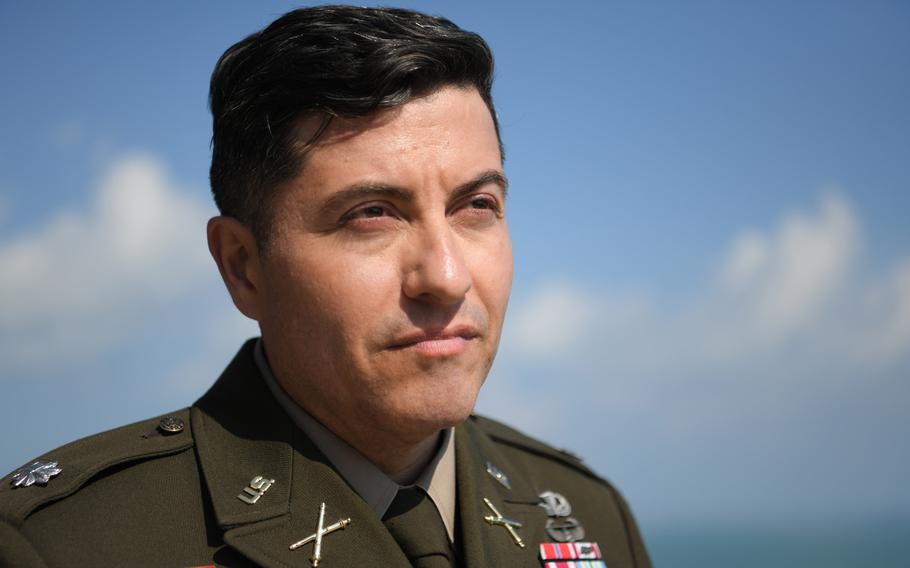
Lt. Col. William Hogan on June 6, 2024, at an observation point overlooking Omaha Beach in Normandy, France, where his father, Lt. Col. Samuel Hogan, landed during World War II. The elder Hogan commanded a tank battalion, which is the subject of a book written by his son that was published in November. (Phillip Walter Wellman/Stars and Stripes)
COLLEVILLE-SUR-MER, France — The last known active-duty soldier to have a father who fought in the Army in World War II is retiring, but not before he takes one last step to keep the memory of the Greatest Generation alive.
Lt. Col. William Hogan, 48, is a foreign area officer based in France, where he works as a liaison between the Pentagon and the French military.
He discussed his new book, “Task Force Hogan: From Normandy to the Elbe,” which chronicles his father’s battalion command and the troops he served with, last week at Normandy American Cemetery during the ceremony commemorating the 80th anniversary of the D-Day beach landings.
“A lot of what they went through is still applicable to our modern Army,” Hogan said.
Samuel M. Hogan was 60 when his son was born. He was 28 when he commanded a reinforced tank battalion under the 3rd Armored Division.
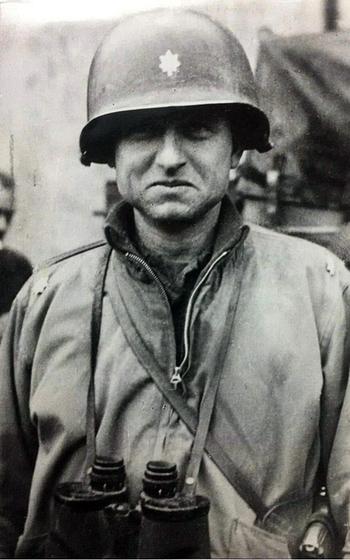
Lt. Col. Samuel Hogan, commander of 3rd Battalion, 33rd Armored Regiment, 3rd Armored Division, also known as Task Force Hogan, pictured sometime during World War II. (U.S. Army Signal Corps)
Arriving in Normandy shortly after D-Day, Task Force Hogan, as the battalion was known, went on to fight on the front lines of some of the war’s toughest battles, pitted against technologically superior enemy tanks and Nazi soldiers with state-of-the-art anti-tank rockets.
In December 1944, during the Battle of the Bulge, German troops surrounded the unit in the Belgian village of Marcouray.
The Americans set up defensive positions but with ammunition running low and no way for supplies to be replenished, Samuel Hogan, then a lieutenant colonel, ordered a nighttime escape by foot.
The group of about 400 men destroyed their vehicles so the enemy couldn’t use them and darkened their faces to make them more difficult to see.
As night fell on Christmas Day, they took cover in the woods, passed enemy lines and trekked more than 10 miles before rejoining other division elements in Soy, Belgium.
Stars and Stripes reported on the feat at the time on Jan. 1, 1945, calling it “an incredible odyssey of American valor.”
Task Force Hogan spent over 200 days in combat, advancing all the way to the Elbe River in Germany, while contributing to a series of offensives by U.S. and Allied forces that led to the Nazi surrender.
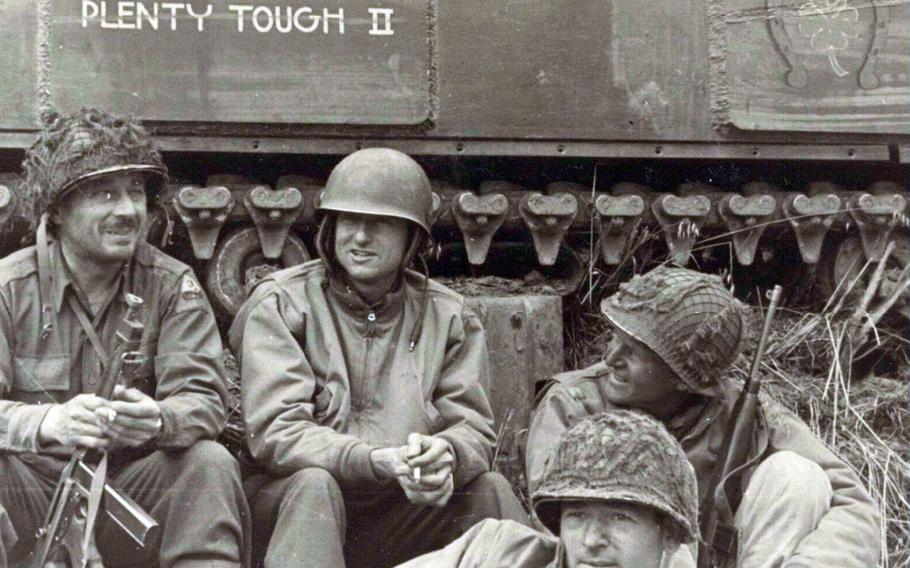
Col. Dorrance Roysdon of the 36th Infantry Regiment, left, Lt. Col. Samuel Hogan, Capt. Edwin Gunderson and Capt. Norbert Horrell of I Company, gather before an attack on Hill 91 near Pont-Hébert, France, in July 1944. (U.S. Army Signal Corps)
The return of traditional, heavy warfare to Europe with the Russia-Ukraine war and the resurgence of great-power competition globally make such stories particularly relevant today, Hogan said.
“What the Russians and Ukrainians are learning about large-scale combat are the things these men learned in World War II,” Hogan said, singling out the importance of logistics and artillery. “All these things that the U.S. Army let rust during 20 years of counterinsurgency are now back under the spotlight.”
Hogan’s primary goal in writing the book is to remind people of the sacrifices that his father’s generation made for freedom.
In the 3rd Division alone, over 2,200 soldiers were killed in action, nearly 7,500 were wounded and about 700 others went missing, according to figures in the book.
Hogan’s nephew, 1st Lt. Samuel McPeak, 26, who is named after his grandfather, believes it would benefit the military if younger service members learned this history.
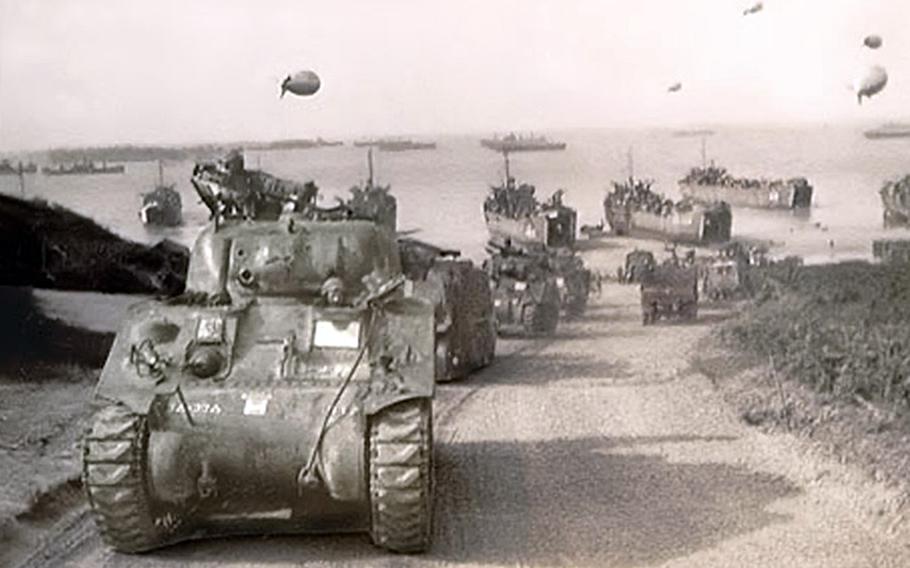
Tanks with 3rd Battalion, 33rd Armored Regiment, 3rd Armored Division, also known as Task Force Hogan, come ashore at Omaha Beach in Normandy, France, shortly after D-Day in 1944. (U.S. Army Signal Corps)
“Most soldiers, especially the new guys coming in, don’t know about the true sacrifices these men made in the Second World War, or even about those who fought in Korea or Vietnam,” McPeak said.
“I think it would give them a lot more pride in knowing that the organization they are a part of did such things and accomplished such remarkable feats for the betterment of the world,” he said. “It helps build esprit de corps.”
McPeak, an Army chaplain candidate, was 7 when his grandfather died in 2005 and remembers him as fit and energetic, even in old age. He was one of the main reasons McPeak chose a military career.
Back at the Normandy American Cemetery, William Hogan, who is planning to retire in September, said it seemed fitting to be wrapping up his career in France. He spends most days working to strengthen U.S.-French military bonds in the face of renewed Russian aggression in Europe.
His father “would have beamed at the thought,” he added.
At the cemetery, he was escorting the Army chief of staff for the remembrance. Earlier that day, he met a surviving member of his father’s 3rd Armored Division for the first time.
“It was very moving,” Hogan said at an observation point overlooking Omaha Beach, where his father arrived in France 80 years ago. “Everything has come full circle.”
Clarification: Lt. Col William Hogan is the last publicly known active-duty soldier with a father who was in the Army in World War II, but another current service member had a father who was part of the Navy Reserve. Perry Martin Brown served aboard the USS Alabama as part of the anti-aircraft gunnery crew until his discharge in 1946 as a seaman first class, according to Col. Jim Brown, an Army command surgeon serving on active duty.
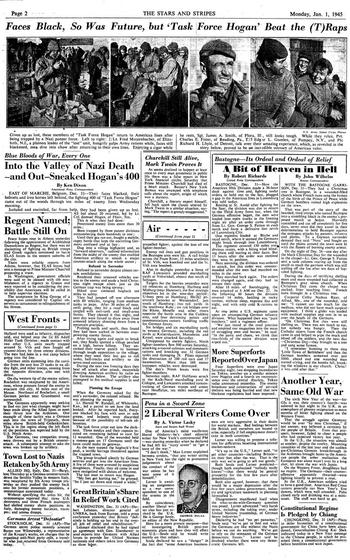
The Stars and Stripes' London edition of Jan. 1, 1945, featured a story about Task Force Hogan, which was led by Lt. Col. Samuel Hogan. (Stars and Stripes)